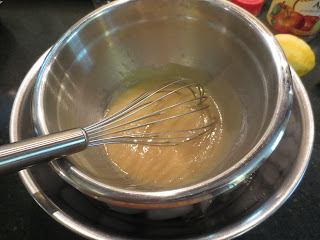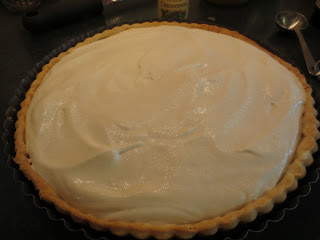So, after a rather long hiatus during which I waited for the daytime highs to get below 100 then coped with prepping for the new semester, I decided to try something a little more ambitious than usual for today's post. I didn't, however, anticipate that it would take all afternoon! Hence the title of today's blog entry.
The recipe comes from a marvelous memoir/biography/cookbook called When French Women Cook: A Gastronomic Memoir with Over 250 Recipes by Madeleine Kamman. Kamman is roughly contemporary with Julia Child, and was a child in France during WWII. She is probably best known for her cookbook The Making of a Cook. This book essentially recounts her own experience with a number of French women before, during, and after WWII. She has chosen women from different regions of France and then gives recipes from each women. Many of the recipes are from the 1930s and 40s, and may stretch into the 19th century. It's a beautifully written book as interesting for the history as it is for the recipes.
Many of the recipes are promising, and today I decided to try one that had captured my attention--La Pommée D'Henriette, or Apple Cream Tart from Normandy. Here's the recipe, as written, and can be found on page 130. Hang on, it's a long one!
LA POMMEE D'HENRIETTE
[Apple Cream Tart]
Servings: 8-12 Cost: reasonable Execution: semi-difficult
Total Preparation Time: 1 hour for the pastry, 1 hour for the filling. Spread the work over two days.
Remarks on Ingredients: Use Grannie Smith, July-September; Gravenstein, July-September; Greening, October-February; Winesap, January-May
Best Season: Follow the apples. No other pie apples resemble the Normandy apples enough to be used.
PASTRY:
1 1/2 cups sifted all-purpose flour (175g)
3/4 cup butter (175 g)
3/4 tsp. salt (7 1/2 g)
4-5 TB water (1/2 dl)
1 tsp. sugar
FILLING:
1 1/2 cups applesauce (3 1/2 dl)
1/8 tsp. cinnamon
1/2 tsp. lemon rind, grated fine
Pinch of salt
1/2 cup apple cider (1 generous dl)
1 envelope gelatin
6 TB Calvados or Apple Jack (1 small dl)
3 TB unsalted butter (35 g)
8 peeled apples, cut into 8 slices each
1 TB sugar (10 g)
TO MAKE THE PASTRY:
Put the flour on the counter and make a well. Cut the butter into 1 1/2-tablespoon chunks and add. Add the salt. With the fingertips, squeeze the butter and flour together to obtain pieces if butter no smaller than 1/3 of a tablespoon. Sprinkle the water over the mixture gradually and mix with the fingertips until the pastry holds together. Let rest on a plate for 30 minutes. Refrigerate. Roll out into a strip 15 inches by 6 inches by 1/2 inch. Fold in three. Turn the package of dough so it looks like a book ready to be opened. Flatten it out again into the same size strip. Fold in three. Refrigerate 15 minutes. Repeat the same operation a second time; refrigerate 15 minutes. Repeat the same operation a third time; refrigerate 15 more minutes. By now you will have given 6 turns altogether. Between the turns keep the dough in the vegetable crisper of the refrigerator and not on one of the shelves; the butter will be flattened and absorbed more readily this way.
Roll the pastry out into an 11inch circle, 1/8 inch thick. Fit it into a 9-inch circular buttered cake pan. Cut away any excess pastry by rolling the pin over the edges of the cake mold. Crimp the edge of the pastry with a fork, prick its bottom, and fit a piece of aluminum into the unbaked pastry. Fill with dried beans or aluminum nuggets, and bake 15 minutes at 425. Remove the beans or nuggets and foil. Sprinkle the bottom of the pie with 1 teaspoon of sugar and continue baking for another five minutes. Gently unfold to cool on a cake rack.
TO MAKE THE FILLING:
Whip the heavy cream until almost mounding. Keep refrigerated. Put the applesauce into a pan with cinnamon and lemon rind; add a tiny pinch of salt and reduce to 1/2 cup. Put the cider in a measuring cup. Sprinkle the gelatin over it and melt it in a hot water bath. Mix with the applesauce. Liquify the mixture in the blender. Pour into a bowl fitted over another, larger bowl containing ice and water. Add 2 tablespoons of the Calvados. Stir until the mixture starts to thicken. Fold in the heavy cream and pour into the prepared pie shell.
Heat the 3 tablespoons of butter in a 10-inch frying pan. Sauté the apple slices over high heat to color them well. Reduce the heat, sprinkle with the sugar, and let the apples soften and glaze. Flambé them with the remaining Calvados or Apple Jack. Let cool. Arrange the apples in concentric circles on top of the cream filling.
Ok, here was my experience with the recipe. First of all those two one-hour segments on top? Pure lies. It took me a good four hours or more, start to finish. I tried to follow the recipe as best I could, but sometimes had to/wanted to make some changes.
First, the pastry dough. This seems a rather complicated way of making what is essentially plain old pie dough. I have seen the trifold technique used when making puff pastry from scratch, but this recipe has you incorporate the butter at the beginning. I thought perhaps this would make the crust something of a cross between puff pastry and pie crust, and that was the case, sort of. All that folding, refrigerating and re-rolling did make for a very pliable dough at the end, which was easy to roll out and place in the cake pan.
 |
| Sifting the flour |
The dough:
The recipe at this point says "Let rest on a plate for 30 minutes. Refrigerate." This stumped me. Let it rest for 30 minutes at room temperature then refrigerate? Let it rest while it is in the refrigerator? I opted to let it do its resting in the 'fridge, since I know pie dough does need refrigeration.
Now comes the first strip and trifold:
And after turning it, rolling it, and trifolding it again, I got this:
I went through the rest of the pastry shell process pretty much as written, with the exception of the cake pan. A cake pan is a rather odd shape for what should be a tart. Perhaps tart pans weren't widely available in the U.S. when the book was written? Anyway, I had 8-inch cake pans or a 10-inch pastry pan. I opted for the pastry pan. Here's the crust all rolled out and ready to blind-bake (pre bake).
And here we are, all finished. I used a little more sugar than the recipe called for.
So far, so good. A lot of work for a pastry shell, but what the heck. It certainly did work. On to the filling! Here's the applesauce mixture, before cooking:
This is where I ran into my first problem. I didn't anticipate how long it would take to cook down by 2/3! In the meanwhile, I had sprinkled the gelatin over the apple cider, and had heated it up to dissolve the gelatin.
Aaaaannnnddd... the applesauce is bubbling anemically, but not reducing much. You can't hold dissolved gelatin at high temps indefinitely (you can see my makeshift hot water bath above). I cranked the heat up on the applesauce. Hey! Applesauce volcano! How exciting! I turned the heat to medium and let it reduce down by 1/3 rather than the requisite 2/3, then called it good. By this time I had been working on the dang applesauce for 25 minutes and needed to move along. Now, I did use a commercial (organic, unsweetened) applesauce rather than homemade. Since homemade tends to be more watery, perhaps the recipe was written with homemade applesauce in mind. Not sure. Did I mention that while I was waiting for the applesauce to cook down, I made the whipped cream?
So, here again I wasn't sure what beating the cream until it was "almost mounding" meant. I guessed that mounding meant a firm whipped cream, so I made one with soft peaks instead. Finally, after getting sick of waiting around for the applesauce, I buzzed the applesauce and apple juice up in a blender, as per the recipe.
Then put the whole thing in an ice bath and added the Calvados. Calvados is an apple liqueur from Normandy, and I just happen to have some on hand for cooking!
 |
| Mmmm... Calvados... |
Back to the ice bath. The mixture actually took very little time to cool and begin to thicken. Ice baths are helpful that way.
Finally, I folded in the whipped cream and poured it all into my prebaked tart shell, then stuck it in the fridge for gelling. The "cream" layer is actually something like an apple bavarian, given the gelatin used to help it set.
I would note that as you rearrange the fridge to fit in the tart, don't drop a package of hot dogs into it as I did. Sometimes it sucks being an uncoordinated klutz.
Finally, the apple topping. 8 apples seemed like an awful lot to me, given the size of the Granny Smith's at the grocery store. I opted for 5 apples worth, cut in more than the suggested eight pieces. I cut the slices about 1/4 to 1/3 inch thick. I melted butter and then dumped them into the pan.
The recipe calls for high heat here so they brown. Unfortunately, I don't think my pan got hot enough because the only browning I got came after they cooked for about 8 minutes and some of the juice cooked off. Things might have worked better in a cast-iron skillet over my hottest burner. Oh well. Next came the fun part--flambé! I called in the kids and gave Cian the camera. What I forgot to do is turn out the lights, but I think you can still see the flame here:
The children were duly impressed, even though they opted not to try the tart when it was done. After everything cooled, I arranged the cooked apples on the tart. Looks not too bad, if I do say so myself.
The verdict? The kids weren't interested (they don't like pies). Husband and I ate slices. It was very tasty, but I'm not sure it was tasty enough to warrant all the time that went into it. And the quantity of dishes which needed to be washed at the end (thank you, Kieran!). I have found quite a few other, more modern recipes out there for apple cream tart-- Laura Calder has a good one: http://www.cookingchanneltv.com/recipes/laura-calder/easy-pastry-shop-apple-tart-recipe/index.html
I think something reasonably similar could be made in about half the time using Calder's recipe. Still, it was a good experience at cooking from an old recipe.


















Pardon the amateur question, but..dried beans? Why? And wouldn't they make the pastry shell taste, y'know....bean-y?
ReplyDeleteIt's called "blind baking" a pie crust. You actually put down a layer of aluminum foil first, then put the beans in. The crust needs something to weigh it down so that it doesn't bubble and warp when you bake it. After about 15 minutes you take the aluminum foil holding the beans out once the crust has set. The beans never actually touch the pie.
ReplyDelete